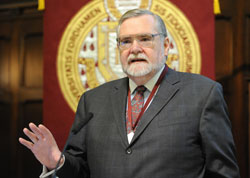 Terrence W. Tilley, Ph.D., chair of the Department of
Theology at Fordham University, was formally installed as the first occupant of
the Avery Cardinal Dulles, S.J., Chair of Catholic Theology. The benefactors of
the Dulles Chair are Vincent and Teresa Viola.
Terrence W. Tilley, Ph.D., chair of the Department of
Theology at Fordham University, was formally installed as the first occupant of
the Avery Cardinal Dulles, S.J., Chair of Catholic Theology. The benefactors of
the Dulles Chair are Vincent and Teresa Viola.Typical in academic settings
like this one the Chair delivers an address of his choosing. Tilley gave
audience his opinion on Saint Ignatius of Loyola's famous Rule 13 in Rules for Thinking with the Church as
found in the Spiritual Exercises. His address: "Sentire cum Ecclesia:
Thinking With and for the Church." Tilley's claim was based on his reading
the of Rule 13 in light of Cardinal Dulles' 1974 and later republished in 2002 with a
new introduction and an essay on Pope John Paul II's ecclesiology, Models of the Church. Models is Dulles' exposition of the 5 ways of knowing the Church.
There is an historical debate as to the intention of Loyola when he formulated Rule 13 because he was hounded by the members of the Inquisition, famously the Dominicans, after a charge of being an adherent of the "Illuminati."Nevertheless, many in the 16th century could not understand how a layman could write such forward thinking and spiritually freeing and orthodox Catholic doctrine as found in the Exercises. In the tussle of what the historical origins of the Rules are Dr Tilley offers a revisionist reading of the Rules. My take is that he distracts more than shed light upon. I really don't care too much about the historical points as much as how does the spiritual patrimony of a great 16th century saint and mystic impact the life of the Church today. Debate or not on the historical background of the Rules, ultimately they remain a crucial part of the knowing and experiencing the Exercises as Loyola understood them and gave them to his spiritual children. Without the Rules for Thinking with the Church or a reductionistic view of the Rules, one is done a dis-service. Debate does not dismiss content. What Tilley recalls for us is that Cardinal Dulles taught that the Rules for Thinking with the Church are "applied" to the exercitant (the one who made the Spiritual Exercises) only after the Exercises were done. They are not lived in the abstract, nor outside the heart of the Church.
Loyola is nothing if not a man of the Church, acknowledged by Tilley but dismissed through the lens of his personal experience of Jesuit education. The example of Loyola is our way of living today. Obedience was paramount for him, and it ought to be the same for us today (cf. Rule 13). And the Rules for Thinking with the Church squarely prove this point especially if you read the Rules in context of the rest of the Exercises.
That's correct: neither God nor human beings live in the abstract. Revelation and reception of revelation is understood in the concrete, in the present, in the contemporaneousness of the Incarnation. In short, it all has to cohere for the faith to be reasonable and intelligible.
In the course of his address Tilley explored Dulles' models of the church (institutional, communion, sacramental, herald and servant), which framed a context for the way the Church works and lives. The latest edition of Models of the Church has a need-to-read introduction by Cardinal Dulles because there he clarifies his thought even more than in the previous edition. If you want to know what Dulles thought, read that introduction!
The best I can say about Dr Tilley's lecture is call for mutual respect and appreciation of another's thought, not reducing the person to the sum of that person's ideas. As he said, "[Cardinal Dulles] teaches us that our opponents in theology and the church are not our enemies, but our friends to whom we must listen and from whom we must learn." Tilley concluded, "After all, they are God's people as much as I am," he explained. "God's unfailing love encompasses all of us. And if God loves my opponents--and even my enemies--must I not learn how to love them, too?"


Leave a comment